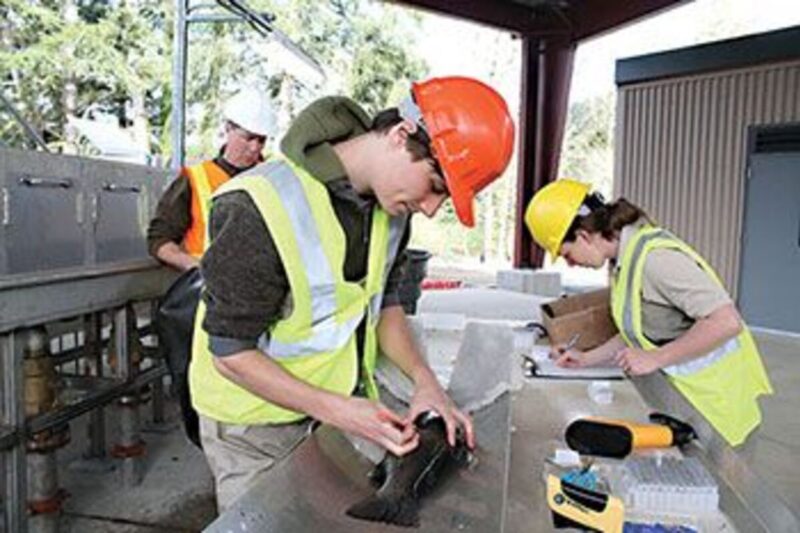Sean C. Morgan
Winter steelhead are getting less personal touch as they negotiate their way past Foster Dam these days.
Once upon a time, fish headed upstream past Foster Dam swam into a basket. Oregon Department of Fish and Wildlife officials would jump into the basket and sort the fish by hand, wild fish into a truck headed upstream or hatchery fish downstream for fishermen.
A $14 million facility went online April 1, allowing fish to move through a series gates and corrals in water-to-water connections and are sorted into holding tanks for transport up or downstream.
The project includes two or three more months of work finishing curbs, grading and landscaping, said Brett Jennings of the Natt McDougall Co., the contractor for the project.
“The first day we tried it, there were 19 fish, and all of it was the winter steelhead,” said David Griffith, fish biologist with the U.S. Army Corps of Engineers.
Some 25 to 30 fish had collected in the facility’s pre-sorting pool Monday after climbing part of the old fish ladder and then the new ladder across the face of the powerhouse and then west to the new facility at Wiley Creek Park.
From there, they drop through a chute to an anesthetic pool where researchers are tagging them and collecting DNA and scale samples. The winter steelhead are loaded and taken to River Bend County Park, where they are emptied into the South Santiam River, and the summer steelhead, which are just beginning to return, are taken downstream to Waterloo County Park. The facility will also capture fish for the South Santiam Hatchery.
Right now, for every fish taken upstream, about one is returning downstream, Griffith said, and the return is even higher with Chinook salmon, the other listed fish species in the river. Officials are hoping to push those numbers higher.
To that end, early on, they’re studying each fish migrating upstream, and eventually the Corps will know details about each migrating steelhead, most of which are about 3 years old with about two years in the ocean.
“The adults coming back up, we’ll know exactly who their parents are,” said Corps Spokesman Scott Clemans, and it will “help us understand what kind of natural wild production we’re getting with these fish we put above the dam. As research gives us a better understanding what these fish need and how they behave, the number of fish we’ll need to work up will be less.”
The new facility adds flexibility and reduces delays getting the fish upstream, said Brett Boyd, manager at the South Santiam Fish Hatchery.
Approximately 350 adult winter steelhead and 4,500 Chinook reach Foster Dam annually, Griffith said.
Upstream isn’t the only concern with Foster Dam. In May, the Corps will install a device in a spillway to detect adult steelhead migrating back out to the ocean as well as juveniles as part of an attempt to figure out the best way to manage downstream passage.
The Corps has conducted a series of tests to determine which route fish are taking downstream, over the spillway or through the powerhouse turbines, and how well they survive passage over or through the dam.
“We’re really pleased,” Griffith said. “Very few bugs we had to work out.”
The Foster facility is already ahead of the similar Minto project on the North Santiam, which went online last year, he said.





